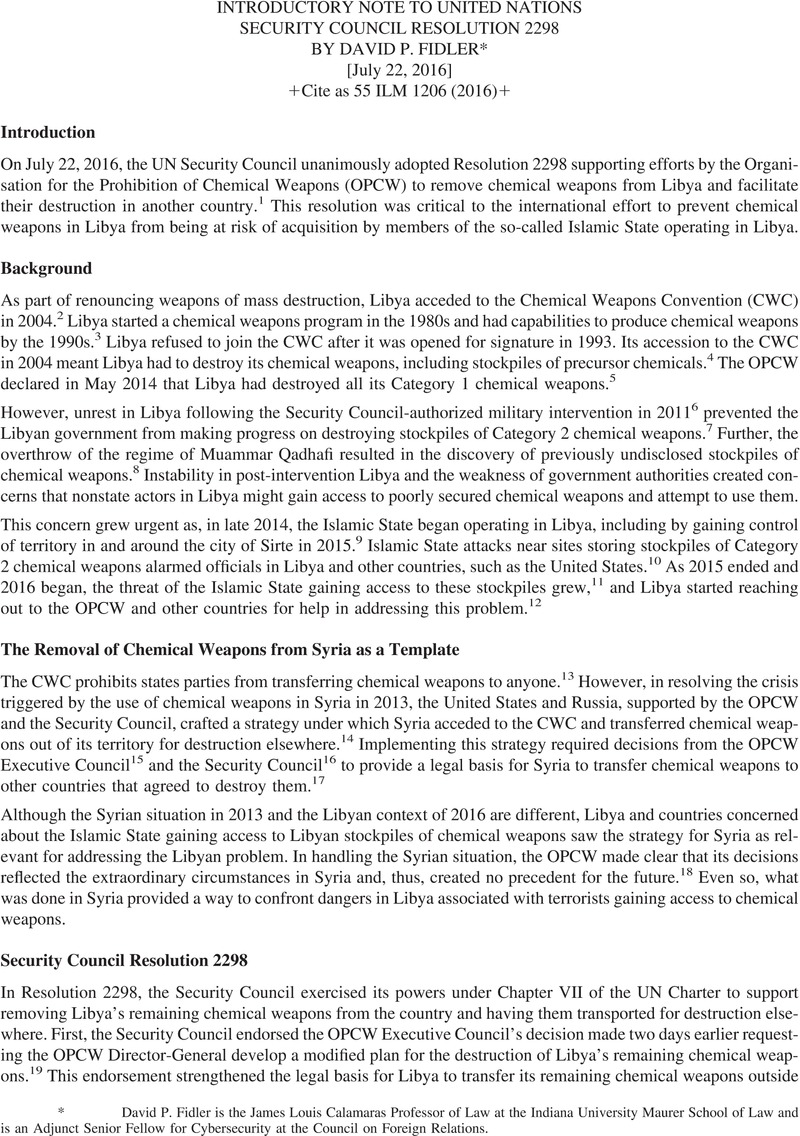No CrossRef data available.
Article contents
United Nations Security Council Resolution 2298
Published online by Cambridge University Press: 27 February 2017
Abstract

- Type
- International Legal Materials
- Information
- Copyright
- Copyright © American Society of International Law 2016
References
Endnotes
1 S.C. Res. 2298 (July 22, 2016).
2 Member State – Libya, Organisation for the Prohibition of Chemical Weapons [OPCW], https://www.opcw.org/about-opcw/member-states/member-states-by-region/africa/member-state-libya/ (last visited Nov. 21, 2016).
3 Libya: Chemical, Nuclear Threat Initiative, http://www.nti.org/learn/countries/libya/chemical (last updated Apr. 2015) [hereinafter Nuclear Threat Initiative].
4 Convention on the Prohibition of the Development, Production, Stockpiling and Use of Chemical Weapons and on Their Destruction arts. I(2), II(1), Sept. 3, 1992, 1974 U.N.T.S. 45 [hereinafter CWC].
5 Libya Completes Destruction of Its Category 1 Chemical Weapons, OPCW (Feb. 4, 2014), https://www.opcw.org/news/article/libya-completes-destruction-of-its-category-1-chemical-weapons. Under the CWC, Category 1 chemical weapons are chemical agents (and munitions filled with such agents) that have been used as chemical weapons or that have few or no peaceful uses (Schedule 1 chemicals). Brief Description of Chemical Weapons, OPCW, https://www.opcw.org/about-chemical-weapons/what-is-a-chemicalweapon (last visited Nov. 21, 2016) [hereinafter Brief Description of Chemical Weapons].
6 S.C. Res. 1973 (Mar. 17, 2011).
7 Nuclear Threat Initiative, supra note 3. Under the CWC, Category 2 chemical weapons are primarily chemicals that serve as precursors for Schedule 1 chemicals and that have some peaceful uses in industry (Schedule 2 chemicals). Brief Description of Chemical Weapons, supra note 5.
8 Nuclear Threat Initiative, supra note 3.
9 David D. Kirkpatrick, Ben Hubbard, and Eric Schmitt, ISIS’ Gap on Libyan City Gives It a Fallback Option, N.Y. Times, Nov. 29, 2015, at A1.
10 Missy Ryan & Greg Jaffe, As ISIS Closed In, A Race to Remove Chemical-Weapon Precursors in Libya, Wash. Post, (Sept. 13, 2016), https://www.washingtonpost.com/world/national-security/as-isis-closed-in-a-race-to-remove-chemical-weapon-precursors-in-libya/2016/09/13/85094326-78f7-11e6-beac-57a4a412e93a_story.html.
11 In Iraq and Syria, the Islamic State used chemical weapons, a track record that informed concerns about its access to chemical weapons in Libya. See Eric Schmitt, ISIS Used Chemical Arms at Least 52 Times in Syria and Iraq, Report Says, N.Y. Times, Nov. 22, 2016, at A9.
12 OPCW Dec. EC-M-51/DEC.1 (Feb. 24, 2016) (noting receipt of communications from Libya and “[n]oting with concern the security situation in Libya and the threat of the remaining chemical weapons stocks falling into the hands of non-State actors”).
13 CWC, supra note 4, art. I(1)(a).
14 U.S. Dep't of State Press Release, Framework for the Elimination of Syrian Chemical Weapons (Sept. 14, 2013), http://www.state.gov/r/pa/prs/ps/2013/09/214247.htm.
15 OPCW Dec., EC-M-33/DEC.1 (Sept. 27, 2013); OPCW Dec., EC-M-34/DEC. 1 (Nov. 15, 2013).
16 S.C. Res. 2118 (Sept. 27, 2013).
17 See Walter Krutzsch, Eric Myjer & Ralf Trapp, Issues Raised by the Accession of Syria to the Chemical Weapons Convention, in The Chemical Weapons Convention: A Commentary 699 (Walter Krutzsch, Eric Myjer & Ralf Trapp, eds. 2014) (analyzing the legal importance of the OPCW Executive Council's decisions and Security Council resolution 2118).
18 OPCW Dec., supra note 15, ¶ 3(d).
19 S.C. Res. 2298, supra note 1, ¶ 1. See OPCW Dec., EC-M-52/DEC.1 (July 20, 2016).
20 Ryan & Jaffe, supra note 10 (reporting that the U.S. government did not want to draw attention to the unanimous Security Council resolution until the chemical weapons had left Libya).
21 S.C. Res. 2298, supra note 1, ¶ 3.
22 See OPCW Dec., EC-M-53/DEC.1 (Aug. 26, 2016).
23 S.C. Res. 2118, supra note 15, ¶ 10.
24 S.C. Res. 1540 (Apr. 28, 2004).
25 S.C. Res. 2298, supra note 1, ¶ 5.
26 Ryan & Jaffe, supra note 10 (reporting that the Libyan chemical weapons were loaded on a Danish ship at the Libyan port of Misurata, which was escorted to Germany by Danish and British naval vessels).
27 For an in-depth discussion of the successful effort to remove chemical weapons from Libya, see Audio Tape: Event on Keeping Chemical Weapons Out of the Hands of Terrorists, held by the Center for Strategic and International Studies (Nov. 10, 2016), https://www.csis.org/events/keepingchemical-weapons-out-hands-terrorists.
* This text was reproduced and reformatted from the text available at the United Nations website (visited November 16, 2016), http://www.un.org/en/ga/search/view_doc.asp?symbol_S/RES/2298(2016).




